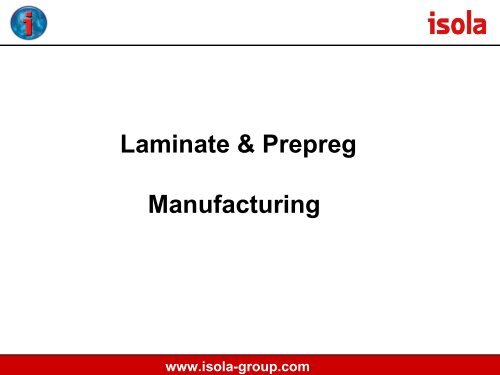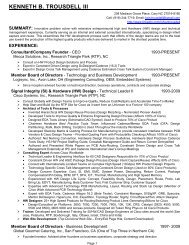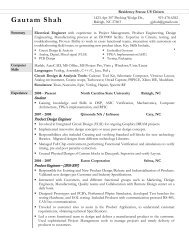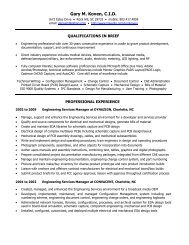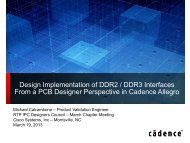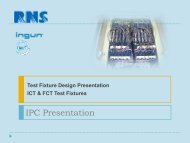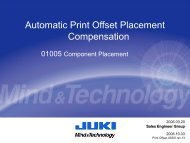Laminate & Prepreg Manufacturing
Laminate & Prepreg Manufacturing
Laminate & Prepreg Manufacturing
You also want an ePaper? Increase the reach of your titles
YUMPU automatically turns print PDFs into web optimized ePapers that Google loves.
<strong>Laminate</strong> & <strong>Prepreg</strong><br />
<strong>Manufacturing</strong><br />
www.isola-group.com
p Treating<br />
p Gamma Gauges for Resin<br />
content control<br />
p On line DCM’s, MMV’s, FTIR’s<br />
p High Shear mixing equipment,<br />
Dedicated lines, Filtration<br />
systems<br />
p <strong>Manufacturing</strong> Focus<br />
<strong>Manufacturing</strong> Technology Focus<br />
p Lay up<br />
p Sandwich copper<br />
concept, separate rooms.<br />
p Controlled Clean room<br />
environment with<br />
Humidity and static<br />
control.<br />
for PWB<br />
Lamination<br />
B-stage for<br />
<strong>Laminate</strong><br />
p Internal contamination Reduction - Controlled environment, Treating technology, handling and lay up<br />
technology.<br />
p <strong>Prepreg</strong> Consistency - Resin content control, On Line cure monitoring, Redundancy with FTIR, Melt viscosity<br />
and Gelation<br />
p Surface quality - Lay up Technology<br />
p Controlled thickness .<br />
p Cost<br />
p Productivity enhancement through lean manufacturing, Re engineered Processes<br />
p QTA<br />
p Fast turn around capability through cycle time reduction, sophisticated scheduling and equipment capability<br />
www.isola-group.com<br />
p Press<br />
p High temperature<br />
pressing capability<br />
p Finishing<br />
p High Speed and precise<br />
finishing capability.
Material Building Blocks<br />
Glass<br />
• Glass fabric is available in different roll widths and thicknesses<br />
• Some glass fabrics are different between North America, Asia Pacific and Europe<br />
• Core constructions are different depending on the region and OEM spec.<br />
Resin<br />
• The resin is determined by what properties are needed to make a particular MLB design<br />
function. ie. Tg, Dk, Df etc.<br />
• The resin must be compatible with the glass fabric<br />
• The resin must be compatible with the copper foil<br />
Copper<br />
• Copper is designated by wt and foil type i.e. Reverse Treat ( RTF ), HTE, Double Treat<br />
or std ED copper foil<br />
• The copper used must be able to achieve good peel strengths so the copper does not<br />
pull away from the glass and resin.<br />
www.isola-group.com
Woven Glass Fabric<br />
OEM designs are calling out the number of plies of glass to be used<br />
per core layer and even calling out the glass fabric style when<br />
controlled impedance is critical.<br />
It is important that we understand the effect of the glass used in the<br />
construction of the core material we give to an OEM. A 2 ply construction<br />
vs. 1 ply will give you a different Dk and Df based on the retained resin %<br />
of the core.<br />
When programs move from one Region to the other please be aware of the<br />
constructions used in the other Regions. For critical OEM’s and designs we<br />
need to try and keep the electrical properties of the material the same ie<br />
the same construction of core material<br />
On the next slide you will see the different glass styles used in North America<br />
Asia Pacific and Europe.<br />
www.isola-group.com
Glass Fabric<br />
www.isola-group.com
Glass Fabric<br />
Glass Weave Warp Fill Warp Fill Fabric Fabric Fabric Fabric<br />
Style Count Count Yarn Yarn Thickness Thickness Nominal Weight Nominal Weight<br />
www.isola-group.com<br />
inches mm OSY g/m2<br />
1067 Plain 70 70 ECD 900-1/0 ECD 900-1/0 0.0013 0.032 0.91 31<br />
106 Plain 56 56 ECD 900-1/0 ECD 900-1/0 0.0015 0.038 0.73 25<br />
1086 Plain 60 60 ECD 450 1/0 ECD 450 1/0 0.0020 0.050 1.60 54<br />
1080 Plain 60 47 ECD 450-1/0 ECD 450-1/0 0.0025 0.064 1.45 49<br />
2113 Plain 60 56 ECE 225-1/0 ECD 450-1/0 0.0029 0.074 2.31 78<br />
2313 Plain 60 64 ECE 225- 1/0 ECD 450-1/0 0.0032 0.080 2.38 81<br />
3313 Plain 61 62 ECDE 300-1/0 ECDE 300-1/0 0.0032 0.081 2.43 82<br />
3070 Plain 70 70 ECDE 300-1/0 ECDE 300-1/0 0.0034 0.086 2.74 93<br />
2116 Plain 60 58 ECE 225-1/0 ECE 225-1/0 0.0038 0.097 3.22 109<br />
1506 Plain 46 45 ECE110-1/1 ECE 110-1/0 0.0056 0.140 4.89 165<br />
1652 Plain 52 52 ECG 150-1/0 ECG 150-1/0 0.0045 0.114 4.09 142<br />
7628 Plain 44 31 ECG 75-1/0 ECG 75-1/0 0.0068 0.173 6.00 203<br />
Fiberglass Yarn Nomenclature<br />
1st Letter E = E-glass ( electrical grade )<br />
2nd Letter C = Continuous Filaments<br />
3rd Letter Filament Diameter D, E, DE, G<br />
Ist number Yardage in one pound<br />
2nd number Number of strands in a yarn/ strands plied or twisted
Photos courtesy of Isola R & D Laboratories<br />
Woven Glass Fabric<br />
www.isola-group.com<br />
106<br />
Warp & Fill Count: 56 x 56 (ends/in)<br />
Thickness: 0.0015” / 0.038 mm<br />
1080<br />
Warp & Fill Count: 60 x 47 (ends/in)<br />
Thickness: 0.0025” / 0.064 mm
Photos courtesy of Isola R & D Laboratories<br />
Woven Glass Fabric<br />
www.isola-group.com<br />
1067<br />
Warp & Fill Count: 70 x 70 (ends/in)<br />
Thickness: 0.0013” / 0.032 mm<br />
1086<br />
Warp & Fill Count: 60 x 60 (ends/in)<br />
Thickness: 0.002” / 0.050 mm
Photos courtesy of Isola R & D Laboratories<br />
Woven Glass Fabric<br />
www.isola-group.com<br />
2113<br />
Warp & Fill Count: 60 x 56 (ends/in)<br />
Thickness: 0.0029” / 0.074 mm<br />
2313<br />
Warp & Fill Count: 60 x 64 (ends/in)<br />
Thickness: 0.0032” / 0.080 mm
3070<br />
50 x<br />
3313<br />
50 x<br />
Photos courtesy of Isola R & D Laboratories<br />
Woven Glass Fabric<br />
www.isola-group.com<br />
3070<br />
Warp & Fill Count: 70 x 70 (ends/in)<br />
Thickness: 0.0034” / 0.086 mm<br />
3313<br />
Warp & Fill Count: 61 x 62 (ends/in)<br />
Thickness: 0.0032” / 0.081 mm
Photos courtesy of Isola R & D Laboratories<br />
Woven Glass Fabric<br />
www.isola-group.com<br />
2116<br />
Warp & Fill Count: 60 x 58 (ends/in)<br />
Thickness: 0.0038” / 0.097 mm<br />
1652<br />
Warp & Fill Count: 52 x 52 (ends/in)<br />
Thickness: 0.0045” / 0.114 mm
Photos courtesy of Isola R & D Laboratories<br />
Woven Glass Fabric<br />
www.isola-group.com<br />
1506<br />
Warp & Fill Count: 46 x 45 (ends/in)<br />
Thickness: 0.0056” / 0.140 mm<br />
7628<br />
Warp & Fill Count: 44 x 32 (ends/in)<br />
Thickness: 0.0068” / 0.173 mm
North America<br />
106<br />
1080<br />
1067<br />
1086<br />
2113<br />
3313<br />
3070<br />
2116<br />
1652<br />
7628<br />
Regional Woven Glass Fabric Styles<br />
Asia-Pacific<br />
106<br />
1035<br />
1078<br />
1080<br />
1067<br />
1086<br />
2313<br />
3313<br />
2116<br />
1501<br />
1506<br />
1652<br />
7628<br />
www.isola-group.com<br />
Europe<br />
106<br />
1080<br />
2113<br />
3070<br />
2116<br />
1634<br />
1647<br />
1651<br />
1501<br />
2165<br />
2157<br />
7628<br />
Isola has Global Std Constructions on the High Performance Materials
Multilayer Core <strong>Manufacturing</strong><br />
www.isola-group.com<br />
Sep. Plate<br />
Copper<br />
2 plies<br />
B-Stage<br />
Copper<br />
Sep. plate
Core/ Construction<br />
0.005” Resin %<br />
1 x 1652 42 %<br />
106 / 2113 54 %<br />
2 x 1080 56 %<br />
1 x 2116 54 %<br />
Typical IS415 0.005” Core Constructions<br />
Positives<br />
Cost/ Thickness/ DS<br />
DS/ Std 2 ply<br />
Low Cost<br />
Low Cost<br />
www.isola-group.com<br />
Negatives<br />
Low Resin/ thick glass<br />
Most Expensive<br />
DS/ Thickness<br />
DS/ Thickness<br />
Dk / Df differences based on retained resin %. The difference can be up to 14 %<br />
At 2 GHz Dk on 42 % = 4.12 Df on 42 % = 0.016<br />
At 2 GHz Dk on 56 % = 3.79 Df on 56 % = 0.0198<br />
Critical that the right core thickness is used by the OEM/ Designer to<br />
meet the impedance criteria.
Grain Direction<br />
www.isola-group.com
18”<br />
50” wide glass<br />
50” x 38” untrimmed<br />
48” x 36” trimmed<br />
oversized panels<br />
available<br />
18”<br />
Grain Direction<br />
24”<br />
24”<br />
50” wide Glass - Fill Direction<br />
www.isola-group.com<br />
Grain Direction<br />
or Warp Direction
Copper Foil<br />
www.isola-group.com
ED Copper Foil <strong>Manufacturing</strong><br />
• Copper is electroplated onto a rotating drum.<br />
• Treatments are applied to:<br />
– Micro-roughen surface for adhesion<br />
– Plate barrier layer<br />
– Coat with anti-tarnish<br />
www.isola-group.com
Copper Foil Types<br />
Copper Foil<br />
ED = standard shiny copper, copper tooth<br />
HTE = High temp elongation shiny copper, copper tooth<br />
RTF = reverse treat, low profile copper tooth<br />
DT = double treat copper, no black oxide needed<br />
The RTF copper foils offer benefits to the fabricator<br />
during processing – more defined etched line, ability<br />
for thinner lines and lower copper tooth profile.<br />
VLP foils are used for better impedance control<br />
95+ % of NA is RTF foil. Very small percentage = DT<br />
Thicker cores still use some HTE or ED foil.<br />
www.isola-group.com<br />
Copper wt<br />
18 micron = H oz<br />
35 micron = 1 oz<br />
70 micron = 2 oz<br />
Heavier copper such<br />
as 3, 4 and 5 oz foil<br />
used for power supply<br />
designs or ground<br />
planes in MLB designs<br />
5 and 6 oz Cu for<br />
Automotive 4 – L designs<br />
12 oz Cu used for<br />
Automotive 2 – L designs
• ED Foil is “Industry<br />
Standard<br />
• Many thicknesses available<br />
– ½, 1 and 2 ounce the<br />
most common<br />
– 3+ available<br />
– 9, 5, 3 micron<br />
Foil Profile Type<br />
Max. Foil<br />
Profile<br />
(Microns)<br />
Electrodeposited Copper Foil<br />
Max. Foil<br />
Profile (μ<br />
Inches)<br />
S – Standard N/A N/A<br />
L – Low Profile 10.2 400<br />
V – Very Low Profile 5.1 200<br />
X – No Treatment or<br />
Roughness<br />
N/A N/A<br />
www.isola-group.com<br />
Grade Foil Description<br />
1 Standard Electrodeposited<br />
2 High Ductility Electrodeposited<br />
3 High Temperature Elongation<br />
Electrodeposited<br />
4 Annealed Electrodeposited<br />
5 As Rolled-Wrought<br />
6 Light Cold Rolled-Wrought<br />
7 Annealed-Wrought<br />
8 As Rolled-Wrought Low-Temperature<br />
Annealable<br />
Common<br />
Industry<br />
Terminology<br />
Area<br />
Weight<br />
(g/m 2 )<br />
Nominal<br />
Thickness<br />
(μm)<br />
Area<br />
Weight<br />
(oz/ft 2 )<br />
Area<br />
Weight<br />
(g/254 in 2 )<br />
Nominal<br />
Thickness<br />
(mils)<br />
Foil<br />
Designator<br />
E 5 μm 45.1 5.0 0.148 7.4 0.20<br />
Q 9 μm 75.9 9.0 0.249 12.5 0.34<br />
T 12 μm 106.8 12.0 0.350 17.5 0.47<br />
H ½ oz 152.5 17.2 0.500 25.0 0.68<br />
M ¾ oz 228.8 25.7 0.750 37.5 1.01<br />
1 1 oz 305.0 34.3 1 50.0 1.35<br />
2 2 oz 610.0 68.6 2 100.0 2.70<br />
3 3 oz 915.0 103.0 3 150.0 4.05<br />
4 4 oz 1220.0 137.0 4 200.0 5.40<br />
5 5 oz 1525.0 172.0 5 250.0 6.75<br />
6 6 oz 1830.0 206.0 6 300.0 8.10<br />
7 7 oz 2135.0 240.0 7 350.0 9.45<br />
10 10 oz 3050.0 343.0 10 500.0 13.50<br />
14 14 oz 4270.0 480.0 14 700.0 18.90
• Matte Side Surface Profile<br />
Copper Surface Profiles<br />
Matte Side of Standard Grade 1 Foil Matte Side of Low Profile Grade 1 Foil<br />
• Standard vs Drum Side Treated Foil ( DSTFoil )<br />
<strong>Laminate</strong><br />
With Standard<br />
Copper<br />
Foil<br />
www.isola-group.com<br />
<strong>Laminate</strong><br />
With DSTFoil ®<br />
Copper<br />
Foil
DSTF Process Introduction<br />
www.isola-group.com
DSTFoil ® Comparison to Standard Copper Foil<br />
Standard<br />
Copper<br />
DSTFoil®<br />
DSTF Process Introduction<br />
www.isola-group.com
DSTF Process Introduction<br />
Standard Foil Clad <strong>Laminate</strong><br />
www.isola-group.com<br />
DSTFoil ® Clad <strong>Laminate</strong>
Definitions<br />
www.isola-group.com
The Electromagnetic Spectrum employed for RF &<br />
Microwave applications<br />
Shortwave radio<br />
3 MHz 10 MHz<br />
30 M<br />
Mobile Radio<br />
30 MHz<br />
VHF TV Begins<br />
FM Broadcast Radio<br />
100 MHz<br />
3 M<br />
HF VHF<br />
RF<br />
Mobile Radio<br />
VHF TV Begins<br />
300 MHz<br />
UHF TV ends<br />
Cellular phone<br />
1 GHz<br />
30 cm<br />
UHF<br />
www.isola-group.com<br />
GPS<br />
PCS<br />
Bluetooth<br />
Wireless LAN<br />
3 GHz<br />
MW<br />
DBS<br />
10 GHz<br />
3 cm<br />
Remote Sensing<br />
30 GHz<br />
MMW
Definitions<br />
TG – Glass Transition Temperature; The temperature at which the resin changes from a glasslike<br />
state to an amorphous state changing its mechanical behavior, i.e. expansion rate<br />
DSC – Differential Scanning Calorimetry; A measurement technique used to characterize the<br />
glass transition temperature of a resin by measuring the change in heat given off the resin.<br />
TMA – Thermal Mechanical Analysis; A measurement technique used to characterize the glass<br />
transition temperature of a resin by measuring the changing in thermal expansion of a resin as a<br />
function of temperature.<br />
DMA – Dynamic Mechanical Testing; A measurement technique used to characterize the glass<br />
transition temperature of a resin by measuring the change in modulus of a resin as a function of<br />
temperature.<br />
TD – Decomposition Temperature; The temperature at which the resin begins to decompose,<br />
measured by a weight change the resin sample.<br />
www.isola-group.com
Definitions<br />
TGA – Thermo-Gravimetric Analysis; A measurement technique used to characterize the<br />
decomposition temperature of a resin by measuring the change in weight as a function of temperature.<br />
CTE – Coefficient of Thermal Expansion; The rate of expansion of a laminate as a function of<br />
temperature change. Typically reported as PPM/°C or %.<br />
T260 – Time-to-Delamination @ 260°C; A measurement conducted on the TMA apparatus in<br />
order to determine a laminate’s resistance to Delamination at 260°C. Delamination is defined as an<br />
irreversible expansion in the z-axis. Measurements are noted in minutes at 260°C before failure.<br />
T288 – Time-to-Delamination @ 288°C; A measurement conducted on the TMA apparatus in<br />
order to determine a laminate’s resistance to Delamination at 288°C. Delamination is defined as an<br />
irreversible expansion in the z-axis. Measurements are noted in minutes at 288°C before failure.<br />
Dk – Permittivity, Relative Dielectric Constant; The property of a material that impedes the<br />
transmission of a electromagnetic wave. The lower the relative dielectric constant, the closer the<br />
performance of the material to that of air. This property is critical to matching the impedance<br />
requirements of certain transmission lines.<br />
www.isola-group.com
Definitions<br />
Df – Loss Tangent; The property of a material that describes how much of the energy transmitted is<br />
absorbed by the material. The greater the loss tangent, the larger the energy absorption into the<br />
material. This property directly impacts the signal attenuation at high speeds.<br />
Peel Strength; This measurement is taken to evaluate the adhesion of the resin to the copper<br />
cladding, in units of lbf/in or N/m. Measurements are taken after samples have been conditioned in the<br />
following manner: as received, after thermal stress, and after chemical processing.<br />
Thermal Stress; This measurement is taken to evaluate the thermal integrity of laminates after shortterm<br />
exposure to solder, 10 seconds at 550°F (288°C). The samples are evaluated for evidence of<br />
blisters and delamination.<br />
www.isola-group.com
Definitions<br />
TCT – Thermal Cycling Test; this type of reliability test is conducted in order to evaluate a PCB’s<br />
resistance to plated-thru-hole failures when exposed to repeated temperatures extremes. Factors in this<br />
test that vary from OEM-to-OEM include temperature ranges, time at given temperatures, and medium<br />
used to heat and cool the PCB (i.e. liquid or air).<br />
IST – Interconnect Stress Test; an accelerated thermal cycling test that utilizes DC current to<br />
heat the PTH and uses forced air to cool the PTH of a PCB coupon. The benefits of using IST in place<br />
of conventional TCT tests include lower cost, failure detection and results within days.<br />
CAF – Conductive Anodic Filament Growth Failure; a PCB reliability issue related to the growth<br />
of copper containing filament along the resin-to-glass interface<br />
www.isola-group.com
Isola<br />
RoHS<br />
Halogen Free<br />
www.isola-group.com
RoHS Compliancy<br />
RoHS Compliancy – Products that are RoHS compliant do not contain<br />
the 6 chemical substances listed on the following slide. These substances are not<br />
to be used in the base chemistry of laminates or prepregs.<br />
A RoHS compliant resin system does not mean that it is Lead Free Assembly<br />
Compatible at 260 C.<br />
ALL Isola Products are RoHS Compliant<br />
www.isola-group.com
EU RoHS Compliance<br />
Restriction of Hazardous Substances<br />
Legislation bans the following Six substances for shipment to EU countries<br />
effective July 1 -2006<br />
Lead ( Pb )<br />
Mercury ( Hg )<br />
Hexavalent Chromium ( Cr 6+ )<br />
Polybrominated biphenyl ( PBB )<br />
Polybrominated diphenyl ether ( PBDE )<br />
Cadmium ( Cd ) - - Max Conc. By Wt. < 0.01 %<br />
High End Networking companies exempt until 2010 and beyond<br />
www.isola-group.com<br />
Max Conc. By Wt. < 0.1 %


